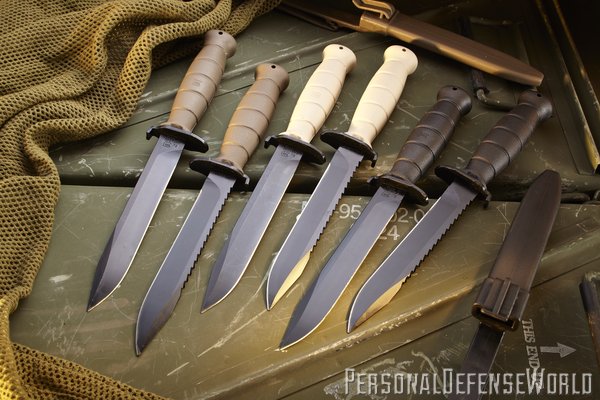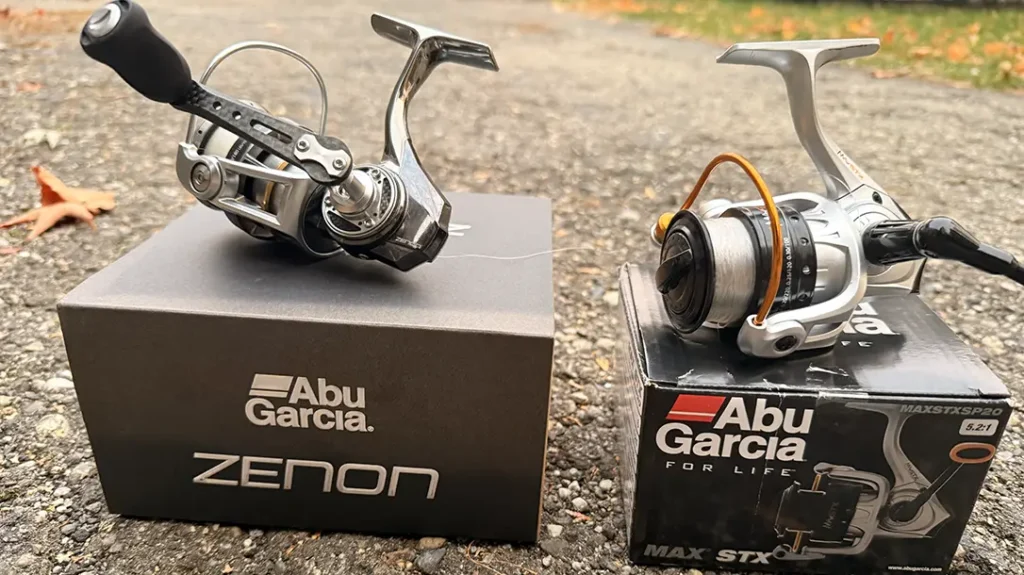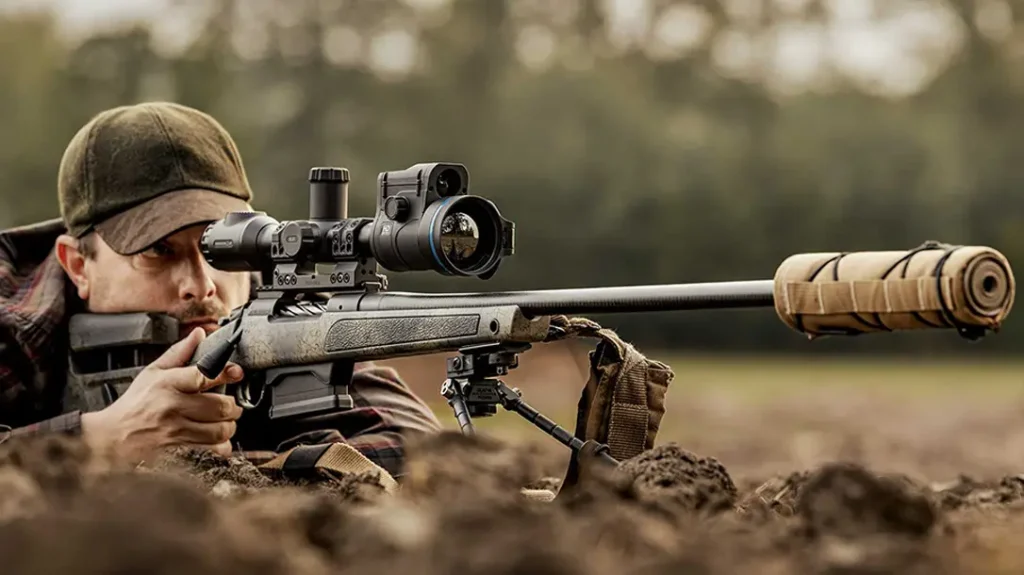The widespread issuing of combat knives to infantry troops is actually a relatively recent military concept. Trench warfare during WWI led to both sides launching small-scale nighttime raids on each other’s positions. It was quickly discovered that a handy close-combat knife was a much more useful weapon than a long bayonet or sword when grappling with the enemy in the bottom of a muddy trench. Though the French and Germans supplied their troops with fairly basic weapons, the U.S. and England favored brass-knuckle-handled monstrosities that would probably earn them “mall ninja” status today. At least in my opinion, it was the Austrians that actually designed and issued the most practical military combat knife of that world-changing conflict. Their knife offered a wide, 8-inch-long, spear-point blade, a plain steel handguard, and an equally utilitarian wood handle that was all about function over flash. It was the kind of knife you could use to whittle kindling, peel a potato, butcher a farmer’s chicken or hold your own in a middle-of-the-night trench fight with equal ease. In short, it was the kind of knife the troops really needed rather than something a rear-echelon ribbon clerk carried in his fantasies.
Apparently, the Austrians have been able to maintain this clear, practical view of military cutlery right up to the present. Case in point: GLOCK’s Field Knife 78 and its close sibling, the Survival Knife 81.
Spec Ops Design
Advertisement — Continue Reading Below
According to military knife historian Homer Brett, the GLOCK Field Knife 78 was originally based on the Zeither 77 bayonet for the standard-issue Austrian AUG assault rifle. With the close cooperation of Austria’s Jagdkommando Special Forces unit, GLOCK converted the bayonet into a world-class military combat knife. It should probably be noted this was actually a few years before they first offered their legendary GLOCK 17 handgun.
The basic specifications of the GLOCK combat knives start with a 6.5-inch-long, phosphate-coated blade of 1095 carbon steel, which is hardened to a tough, easy-to-resharpen Rockwell hardness of 55 HRC. The modest steel handguard doubles as a bottle opener in the field. Both the sheath and the handle of each knife are made from GLOCK’s own polymer thermoplastic and are currently available in a choice of olive drab, desert sand or midnight black colors. The knives alone weigh 7 or 9 ounces in the sheath. The suggested retail price runs around $30 for both versions.
One of the first things you notice about the GLOCK knives is how light they feel compared to the average military-issue combat blade. Every ounce counts on the modern combat load-out, and it is hard to match the GLOCK models for this in the full-size battle blade category. The best part of this weight reduction is that it comes at no sacrifice in strength or durability. I have literally taken GLOCK knives in their sheaths and pounded them on the side of trees and similar hard objects without managing to crack or damage them. The blades are equally strong and will stand up to any reasonable use that can be expected of a knife. This seems to include throwing, as I have seen numerous references to the Austrian army considering this an accepted use in their original specs.
Advertisement — Continue Reading Below
Soldier Survival
Abused and well-worn knives might rust. GLOCK knives have an anti-corrosive coating. The polymer sheath is unlike conventional leather. It will not absorb oil or grease. This helps keep any corrosion protection in place on the blade longer. Under really extreme conditions, say an amphibious landing, the scabbard can literally be filled with a heavy grease to protect the blade from moisture. The scabbard is totally ambidextrous, and with practice the blade-retention clasp can be operated with one hand. It also lacks a lot of the “bells and whistles” common to modern commercial combat knives, thus making for a sleek, compact package that is much easier to position among your other battle rattle.
GLOCK knife edges are on the low end of shaving sharp. I had a feeling my faithful old Norton cradle three-sided benchstone could easily improve on that. About four minutes’ work on the medium and fine sides of the system had one of the Survival Knife 81s shaving like a razor.
Advertisement — Continue Reading Below
The sawteeth on the back of the Survival Knife 81 are probably not going to replace your average carpenter’s handsaw, but they do make the knife more versatile in emergency situations. Most modern military designers originally added teeth to the spines of their blades back in the 1950s to allow troops to cut their way through the thin aluminum bodies and Plexiglas of downed aircraft rather than to actually saw wood. As a normal survival tool, they can also be used to girdle small sections of firewood with a shallow notch. The wood can then be cleanly broken on the line by a quick blow against a hard object. GLOCK’s sawteeth also work well for carving notches on the small parts of deadfall traps and for rasping dry sawdust from kindling when building camp fires. If you are trying to make your mind up between the 78 and 81, I can see no real downside to the sawback model for normal law enforcement officers and civilian outdoor use, and several potential advantages. The knife also would be the obvious first choice for pilots and flight crews.
The Field Knife 78 is currently issued to various Austrian military units, including their spec-ops groups, Germany’s GSG-9 anti-terrorist teams, and in a number of smaller countries. At various times, I’ve heard that many U.S. Navy SEALs privately purchase and carry GLOCK knives for their durability. Yet, under combat conditions you never know when you are going to be forced to drop, lose, or have your equipment destroyed by battle damage. Everything you carry needs to be expendable if that is what it takes to complete the mission. The GLOCK Field Knife 78 is an ideal cutting tool for working under those conditions.
Enlisted Man’s Friend
Advertisement — Continue Reading Below
It also probably goes without saying that the GLOCK Field Knife 78 is a perfect combat knife for the enlisted troop living on a tight budget. For well under $50, he or she can obtain a totally practical battle blade without sacrificing field performance in any way. Realistically, about 99.9 percent of the time, an infantryman’s knife tends to be used as a tool for rough field living rather than as a weapon, but that is not to say they don’t need the insurance an effective blade provides if things really go bad on a dark night in the middle of no-man’s land. Keep it clean and sharp, and the GLOCK 78 will serve well as that silent companion.
With 36 years of solid field-testing with some the most elite military units in the world, the GLOCK Field Knife 78 and Survival Knife 81 are proven performers that won’t let you down.
























